Overview
- Brief Narrative
- Pendant given to Margarete Grünbaum (later Margaret Gruenbaum) in Theresienstadt ghetto-labor camp by a fellow inmate who worked with her in the camp’s Arts Department between November 1942 and May 1945. Before Czechoslovakia was occupied by Germany in 1939, Margarete lived in Prague with her husband, Karel, and their children, Marietta and Michael. In October 1941, Karel was arrested by the Gestapo and detained in Pankrác prison in Prague. On December 3, Karel was sent to Theresienstadt ghetto-labor camp, where he was killed on the 18th in the Small Fortress. On November 20, 1942, Margarete, Michael, and Marietta were sent to the ghetto-labor camp aboard transport Cc. Margarete was sent to work in the art studio where she made artificial flowers, teddy bears, and stage sets for theater productions. When the family received orders for deportation to Auschwitz killing center in German-occupied Poland in the fall of 1944, Margarete’s job in the workshop saved her family. She asked her boss, the Dutch artist, Josef Spier, to help her convince the German camp guard in charge of the department that her work, creating teddy bears and others toys for Germans for the Christmas season, was important enough to keep her and her children in Terezín. The guard wanted toys for his family, so he removed them from the transport list and they remained at Theresienstadt. They were liberated from the camp on May 8, 1945, by the Soviet Army.
- Date
-
received:
1942 November 20-1945
- Geography
-
creation:
Theresienstadt (Concentration camp);
Terezin (Ustecky kraj, Czech Republic)
- Credit Line
- United States Holocaust Memorial Museum Collection, Gift of Michael Gruenbaum
- Contributor
-
Subject:
Margaret Gruenbaum
Subject: Michael Gruenbaum
- Biography
-
Margarete Popper (1899-1974) was born in Leitmeritz, Austria-Hungary (now Litomerice, Czech Republic). In 1925, she married Karel Grünbaum (1897-1941), who was born in Ceska Kamenice, to Eduard and Elizabeth Zucker Grünbaum. They had two children, Marietta (1926-2008) and Michael (b.1930). The family lived a very comfortable life in Prague. Karel, like his father and brother, was a prosperous attorney. He was one of the most prominent lawyers at the firm of Petschek & Co. He was also active in several Jewish communal organizations, and regularly took Michael to the synagogue with him. In the fall of 1938, the Munich Pact was signed, allowing Germany to annex the Czech Sudetenland border region.
On March 15, 1939, Germany violated the pact by seizing the remaining Czechoslovakian regions of Bohemia and Moravia. Karel was in England on business at the time, but he soon returned home. Not long after, he lost his position at the firm, and the family’s property was confiscated because they were Jewish. The family was forced to wear yellow Star of David patches and leave their apartment. Margarete and Karel moved to a smaller apartment, while the children moved in with relatives. Later, they were all forced to move to the ghetto in Prague, and Michael was expelled from school. In September 1941, Reinhard Heydrich became Reich Protector of occupied Bohemia and Moravia. The persecution of Jews increased, and deportation plans were formed by German authorities. In October 1941, Karel was arrested by the Gestapo and detained in Pankrác prison in Prague. On December 3, Karel, was sent to Theresienstadt ghetto-labor camp, which had opened about 60 miles north of Prague on November 24. Karel was transferred to the Small Fortress at Theresienstadt bearing the designation Return Undesirable (RU). He was murdered there on December 18, 1941. After learning of Karel’s death, Margarete began to entrust the family’s few remaining valuables to non-Jewish friends throughout the city, with the hope of returning for them later.
Transports of Jews from Prague to Theresienstadt soon became frequent. On November 20, 1942, Margarete, Michael, and Marietta were sent to the ghetto-labor camp aboard transport Cc. Males and females were housed separately, so Michael was placed with a group of boys, later known as the Nešarim (Eagles), in the children’s home, L-417, under the leadership of Franta Maier. Margarete was assigned to work in the studio at the camp’s Art’s Department manufacturing teddy bears, artificial flowers, and stage sets for various camp productions. Her boss, a Dutch Jewish artist named Joseph Spier, was the head of the Arts Department and had a son Michael’s age. Michael worked in the garden and bakery, and sang in the children’s choir for the musical productions. Marietta worked in the camp laundry. Whenever Margarete’s family was placed on a transport list to the east, she would remind the key Jewish people in the camp that her husband had contributed so much to the Jewish community of Prague. This helped them get removed from several transport lists in 1943 and 1944. At some point during this time, Margarete received an encoded postcard from her sister-in-law, who had been deported to Auschwitz concentration camp in German-occupied Poland. The text on the card was written with a downward slant, which was the agreed-upon signal to convey that her life there was in danger. The card also warned that Theresienstadt inmates were being deported to Auschwitz, and Margarete became more determined not to be deported.
In the fall of 1944, the family received an order for deportation to Auschwitz. There were too few Jews left in the camp for Margarete’s previous approach to save the family from the transport. Instead she went to her boss, Joseph Spier for help. Margarete was able to help him convince the German camp guard in charge of the department that her work, creating teddy bears and others toys for Germans for the Christmas season, was important enough to keep her and her children in the camp. Since the guard also wanted toys for his family, he gave Margarete a signed slip of paper that excused her and the children from the transport. They still had to go to the assembly point, but were deemed protected and not deported. A few days later, they were sent back to the assembly point. However, due to their protected status, they were able to go wait in one of three rooms full of protected status people. They waited in the room furthest back from the train as the guards began loading the transport. Once all the selected people were loaded, more were still needed to meet the 1,000 person quota, so guards began pulling individuals that had been removed from the transport. People from the first and second waiting rooms were taken to the transport, but no one was taken from the third room where Margarete, Michael, and Marietta were waiting fearfully. Eventually, the full transport left, and the family was able to stay in Theresienstadt. Margarete, Michael, and Marietta were liberated from Theresienstadt on May 8, 1945, by the Soviet Army.
Margarete, Michael, and Marietta returned to Prague and managed to get an apartment in their old building, which had belonged to some Germans who had been evicted. Margarete decided that the family should immigrate to the United States. While waiting for their US visas, Margerete sent Marietta to England in 1946, to pursue her studies. The following year, Marietta won a B’nai Brith scholarship to attend the University of Wisconsin in the US. While studying there, she met her husband, Milton Emont. In February 1948, the Communist Party took control of the government during the Czechoslovak coup d’état. This caused Margarete and Michael to leave in April, when they flew to Cuba to await permission to enter the United States. After living there for two years, they were granted US visas and arrived in New York City on July 4, 1950. Margarete changed her name to Margaret Gruenbaum, found a clerical job, and rented a small apartment. Michael earned a degree in civil engineering from MIT in 1953. He spent the next two years in the US Army, serving as a draftsman in Washington, DC. After his service, he got a position with the Illinois Highway Department. In Chicago, he met Thelma Yutan (1932-2006). The couple married in 1956, and had three sons. After receiving his Master’s degree from Yale, Michael worked as a city planner and settled in Brookline, Massachusetts with his family. Marietta and Milton settled in Granville, Ohio, where they both taught at Denison University, and had two children.
Michael (Misa) Grünbaum (1930-2023) was born in Prague, Czechoslovakia (Czech Republic), to Karel (1897-1941) and Margarete (1899-1974) Popper Grünbaum. Karel was born in Ceska Kamenice, Austria-Hungary (now Czech Republic) to Eduard and Elizabeth Zucker Grünbaum. Margarete was born in Leitmeritz (now Litomerice, Czech Republic). Michael had an older sister Marietta (1926-2008). The family lived a very comfortable life in Prague. Michael’s father, as well as his paternal grandfather and uncle, were prosperous attorneys. Michael’s father, Karel, was one of the most prominent lawyers at the firm of Petschek & Co. He was also active in several Jewish communal organizations. In the fall of 1938, the Munich Pact was signed, allowing Germany to annex the Czech Sudetenland border region.
On March 15, 1939, Germany violated the pact by seizing the remaining Czechoslovakian regions of Bohemia and Moravia. Karel was in England on business at the time, but he soon returned home. Not long after, he lost his position at the firm, and the family’s property was confiscated because they were Jewish. The family was forced to wear yellow Star of David patches and leave their apartment. Margarete and Karel moved to a smaller apartment, while the children moved in with relatives. Later, they were all forced to move to the ghetto in Prague, and Michael was expelled from school. In September 1941, Reinhard Heydrich became Reich Protector of occupied Bohemia and Moravia. The persecution of Jews increased, and deportation plans were formed by German authorities. In October 1941, Michael’s father, Karel, was arrested by the Gestapo and detained in Pankrác prison in Prague. On December 3, Karel, was sent to Theresienstadt ghetto-labor camp, which had opened about 60 miles north of Prague on November 24. Karel was transferred to the Small Fortress at Theresienstadt bearing the designation Return Undesirable (RU). He was murdered there on December 18, 1941. After learning of Karel’s death, Michael’s mother, Margarete, began to entrust the family’s few remaining valuables to non-Jewish friends throughout the city, with the hope of returning for them later.
Transports of Jews from Prague to Theresienstadt soon became frequent. On November 20, 1942, Margarete, Michael, and Marietta were sent to the ghetto-labor camp aboard transport Cc. Males and females were housed separately, so Michael was placed with a group of boys, later known as the Nešarim (Eagles), in the children’s home, L-417, under the leadership of Franta Maier. The boys all became quite close, and were able to participate in activities that Franta planned for them, even though some were officially banned by the guards. Sometimes they were able to read books and conduct secret classes. At other times, they played soccer with other groups of boys and participated in the camp musical and theatrical performances. Margarete was assigned to work in the studio at the camp’s Art’s Department manufacturing teddy bears and artificial flowers. Michael worked in the garden and bakery, and sang in the children’s choir for the musical productions. Marietta worked in the camp laundry. Whenever Michael’s family was placed on a transport list to the east, his mother would remind the key Jewish people in the camp that her husband had contributed so much to the Jewish community of Prague. This helped them get removed from several transport lists in 1943 and 1944. At some point during this time, Michael’s mother received an encoded postcard from his paternal aunt, who had been deported to Auschwitz concentration camp in German-occupied Poland. The text on the card was written with a downward slant, which was the family’s agreed-upon signal to convey where she had been deported was bad. The card also warned that Theresienstadt inmates were being deported to Auschwitz, and his mother became more determined not to let the family be deported.
In the fall of 1944, the family received an order for deportation to Auschwitz. There were too few Jews left in the camp for Margarete’s previous approach to save the family from the transport. Instead she went to her boss, Joseph Spier for help. Margarete was able to help him convince the German camp guard in charge of the department that her work, creating teddy bears and others toys for Germans for the Christmas season, was important enough to keep her, Michael, and Marietta in the camp. Since the guard also wanted toys for his family, he gave Margarete a signed slip of paper that excused the family from the transport. They still had to go to the assembly point, but were deemed protected and not deported. A few days later, they were sent back to the assembly point. However, due to their protected status, they were able to go wait in one of three rooms full of other protected status people. They waited in the room furthest back from the train as the guards began loading the transport. Once all the selected people were loaded, more were still needed to meet the 1,000 person quota, so guards began pulling individuals that had been removed from the transport. People from the first and second waiting rooms were taken to the transport, but no one was taken from the third room where Margarete, Michael, and Marietta were waiting fearfully. Eventually, the full transport left, and the family was able to stay in Theresienstadt. Michael, Margarete, and Marietta were liberated from Theresienstadt on May 8, 1945, by the Soviet Army.
They returned to Prague and managed to get an apartment in their old building, which had belonged to some Germans who had been evicted. Margarete decided that the family should immigrate to the United States. Michael’s sister, Marietta, was sent to England in 1946 to pursue her studies. The following year, Marietta won a B’nai Brith scholarship to attend the University of Wisconsin in the US. While studying there, she met her husband, Milton Emont. In February 1948, the Communist Party took control of the government during the Czechoslovak coup d’état. This caused Michael and Margarete to leave in April, when they flew to Cuba to await permission to enter the United States. After living there for two years, they were granted US visas and arrived in New York City on July 4, 1950. Michael’s mother changed her name to Margaret, and the family’s surname to Gruenbaum. His mother found a clerical job and rented a small apartment. In 1953, Michael earned a degree in civil engineering from MIT. He spent the next two years in the US Army, serving as a draftsman in Washington, DC. After his service, he got a position with the Illinois Highway Department. In Chicago, he met Thelma Yutan (1932-2006.) The couple married in 1956, and had three sons. After receiving his Master’s degree from Yale, Michael worked as a city planner and settled in Brookline, Massachusetts with his family in 1968. Marietta and Milton settled in Granville, Ohio, where they both taught at Denison University, and had two children. Thelma wrote a book, Nešarim, Child Survivors of Terezín, about Michael’s experience.
Physical Details
- Classification
-
Jewelry
- Category
-
Necklaces
- Object Type
-
Pendants (Jewelry) (lcsh)
- Genre/Form
- Jewelry.
- Physical Description
- Heavy, circular, silver-colored metal pendant with a thick border around a cut-out, 6-pointed Star of David with a solid, hexagonal center. The points of the star overlap slightly with the inner edge of the border, and the central hexagon is outlined by engraved lines. There is a tiny, rectangular suspension hole in the circular border between two of the star’s points. The front is discolored to a gold tone at the center, and blackish tones along segments of the border. The back is a dull, dark, discolored silver color with a darker diagonal streak across the center.
- Dimensions
- overall: | Diameter: 1.500 inches (3.81 cm)
- Materials
- overall : metal
Rights & Restrictions
- Conditions on Access
- No restrictions on access
- Conditions on Use
- No restrictions on use
Keywords & Subjects
- Topical Term
- Child concentration camp inmates--Czech Republic--Terezín (Ustecky kraj)--Biography. Concentration camp inmates--Czech Republic--Terezín (Ustecky kraj) Concentration camp inmates as artists--Czech Republic--Terezín (Ustecky kraj) Holocaust, Jewish (1939-1945)--Czech Republic--Personal narratives. Jewish children in the Holocaust--Czech Republic--Biography. Jewish families--Czechoslovakia--Biography.
- Geographic Name
- Prague (Czech Republic) Terezin (Ustecky kraj, Czech Republic) England. Cuba. United States.
- Corporate Name
- Theresienstadt (Concentration camp)
Administrative Notes
- Legal Status
- Permanent Collection
- Provenance
- The Star of David pendant was donated to the United States Holocaust Memorial Museum in 2006 by Michael Gruenbaum, the son of Margaret Gruenbaum.
- Record last modified:
- 2023-09-01 09:00:08
- This page:
- https://collections.ushmm.org/search/catalog/irn36848
Download & Licensing
In-Person Research
- By Appointment
- Request 21 Days in Advance of Visit
- Plan a Research Visit
- Request to See This Object
Contact Us
Also in Margaret Gruenbaum family collection
The collection consists of six handcrafted metal artifacts, documents, a memory book, and a scrapbook album related to the experiences of Margaret Gruenbaum and her children, Marietta and Michael, in Czechoslovakia before and during the Holocaust. The collection also includes a photocopy of a Terezin diary written in German by an unknown woman and a two-page description of a transport to Theresienstadt. Some of these materials may be combined into a single collection in the future.
Date: approximately 1940-approximately 1945
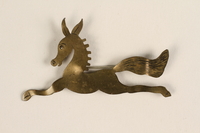
Horse-shaped metal pin made by a Jewish prisoner in Theresienstadt ghetto-labor camp
Object
Pin given to Margarete Grünbaum (later Margaret Gruenbaum) in Theresienstadt ghetto-labor camp by a fellow inmate who worked with her in the camp’s Arts Department between November 1942 and May 1945. Before Czechoslovakia was occupied by Germany in 1939, Margarete lived in Prague with her husband, Karel, and their children, Marietta and Michael. In October 1941, Karel was arrested by the Gestapo and detained in Pankrác prison in Prague. On December 3, Karel was sent to Theresienstadt ghetto-labor camp, where he was killed on the 18th in the Small Fortress. On November 20, 1942, Margarete, Michael, and Marietta were sent to the ghetto-labor camp aboard transport Cc. Margarete was sent to work in the art studio where she made artificial flowers, teddy bears, and stage sets for theater productions. When the family received orders for deportation to Auschwitz killing center in German-occupied Poland in the fall of 1944, Margarete’s job in the workshop saved her family. She asked her boss, the Dutch artist, Josef Spier, to help her convince the German camp guard in charge of the department that her work, creating teddy bears and others toys for Germans for the Christmas season, was important enough to keep her and her children in Terezín. The guard wanted toys for his family, so he removed them from the transport list and they remained at Theresienstadt. They were liberated from the camp on May 8, 1945, by the Soviet Army.
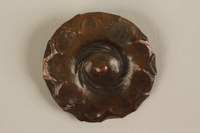
Metal flower pin made by a Jewish prisoner in Theresienstadt ghetto-labor camp
Object
Pin given to Margarete Grünbaum (later Margaret Gruenbaum) in Theresienstadt ghetto-labor camp by a fellow inmate who worked with her in the camp’s Arts Department between November 1942 and May 1945. Before Czechoslovakia was occupied by Germany in 1939, Margarete lived in Prague with her husband, Karel, and their children, Marietta and Michael. In October 1941, Karel was arrested by the Gestapo and detained in Pankrác prison in Prague. On December 3, Karel was sent to Theresienstadt ghetto-labor camp, where he was killed on the 18th in the Small Fortress. On November 20, 1942, Margarete, Michael, and Marietta were sent to the ghetto-labor camp aboard transport Cc. Margarete was sent to work in the art studio where she made artificial flowers, teddy bears, and stage sets for theater productions. When the family received orders for deportation to Auschwitz killing center in German-occupied Poland in the fall of 1944, Margarete’s job in the workshop saved her family. She asked her boss, the Dutch artist, Josef Spier, to help her convince the German camp guard in charge of the department that her work, creating teddy bears and others toys for Germans for the Christmas season, was important enough to keep her and her children in Terezín. The guard wanted toys for his family, so he removed them from the transport list and they remained at Theresienstadt. They were liberated from the camp on May 8, 1945, by the Soviet Army.
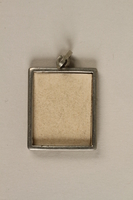
Miniature picture frame pendant made by a Jewish prisoner in Theresienstadt ghetto-labor camp
Object
Pendant given to Margarete Grünbaum (later Margaret Gruenbaum) in Theresienstadt ghetto-labor camp by a fellow inmate who worked with her in the camp’s Arts Department between November 1942 and May 1945. Before Czechoslovakia was occupied by Germany in 1939, Margarete lived in Prague with her husband, Karel, and their children, Marietta and Michael. In October 1941, Karel was arrested by the Gestapo and detained in Pankrác prison in Prague. On December 3, Karel was sent to Theresienstadt ghetto-labor camp, where he was killed on the 18th in the Small Fortress. On November 20, 1942, Margarete, Michael, and Marietta were sent to the ghetto-labor camp aboard transport Cc. Margarete was sent to work in the art studio where she made artificial flowers, teddy bears, and stage sets for theater productions. When the family received orders for deportation to Auschwitz killing center in German-occupied Poland in the fall of 1944, Margarete’s job in the workshop saved her family. She asked her boss, the Dutch artist, Josef Spier, to help her convince the German camp guard in charge of the department that her work, creating teddy bears and others toys for Germans for the Christmas season, was important enough to keep her and her children in Terezín. The guard wanted toys for his family, so he removed them from the transport list and they remained at Theresienstadt. They were liberated from the camp on May 8, 1945, by the Soviet Army.
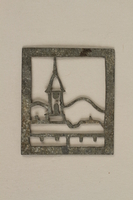
Cut-out landscape scene made by a Jewish prisoner in Theresienstadt ghetto-labor camp
Object
Miniature metalwork given to Margarete Grünbaum (later Margaret Gruenbaum) in Theresienstadt ghetto-labor camp by a fellow inmate who worked with her in the camp’s Arts Department between November 1942 and May 1945. Before Czechoslovakia was occupied by Germany in 1939, Margarete lived in Prague with her husband, Karel, and their children, Marietta and Michael. In October 1941, Karel was arrested by the Gestapo and detained in Pankrác prison in Prague. On December 3, Karel was sent to Theresienstadt ghetto-labor camp, where he was killed on the 18th in the Small Fortress. On November 20, 1942, Margarete, Michael, and Marietta were sent to the ghetto-labor camp aboard transport Cc. Margarete was sent to work in the art studio where she made artificial flowers, teddy bears, and stage sets for theater productions. When the family received orders for deportation to Auschwitz killing center in German-occupied Poland in the fall of 1944, Margarete’s job in the workshop saved her family. She asked her boss, the Dutch artist, Josef Spier, to help her convince the German camp guard in charge of the department that her work, creating teddy bears and others toys for Germans for the Christmas season, was important enough to keep her and her children in Terezín. The guard wanted toys for his family, so he removed them from the transport list and they remained at Theresienstadt. They were liberated from the camp on May 8, 1945, by the Soviet Army.
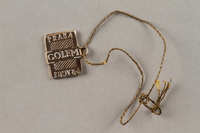
Golem pendant made by a Jewish prisoner in Theresienstadt ghetto-labor camp
Object
Pendant given to Margarete Grünbaum (later Margaret Gruenbaum) in Theresienstadt ghetto-labor camp by a fellow inmate who worked with her in the camp’s Arts Department between November 1942 and May 1945. Before Czechoslovakia was occupied by Germany in 1939, Margarete lived in Prague with her husband, Karel, and their children, Marietta and Michael. In October 1941, Karel was arrested by the Gestapo and detained in Pankrác prison in Prague. On December 3, Karel was sent to Theresienstadt ghetto-labor camp, where he was killed on the 18th in the Small Fortress. On November 20, 1942, Margarete, Michael, and Marietta were sent to the ghetto-labor camp aboard transport Cc. Margarete was sent to work in the art studio where she made artificial flowers, teddy bears, and stage sets for theater productions. When the family received orders for deportation to Auschwitz killing center in German-occupied Poland in the fall of 1944, Margarete’s job in the workshop saved her family. She asked her boss, the Dutch artist, Josef Spier, to help her convince the German camp guard in charge of the department that her work, creating teddy bears and others toys for Germans for the Christmas season, was important enough to keep her and her children in Terezín. The guard wanted toys for his family, so he removed them from the transport list and they remained at Theresienstadt. They were liberated from the camp on May 8, 1945, by the Soviet Army.
Michael Gruenbaum collection
Document
Collection consists of a large scrapbook with a burlap cover, small memory book, and several documents. Consists of one album created by Margaret Gruenbaum, mother of the donor, while imprisoned in Terezin. Includes cloth badges, receipts, notifications, flyers, stamps, artwork and other documents collected in wartime Terezin. Also includes one memory book, entitled "Pamatnik" created by Michael Gruenbaum and friends while living in Room 7, Building L 417 in Terezin. Includes translations of the memory book, of poetry written by Michael and the other children, and loose documents from Terezin.
Michael Gruenbaum collection
Document
Photocopy of Terezin diary written in German by unknown woman and 2 page description of a transport to Theresienstadt.



